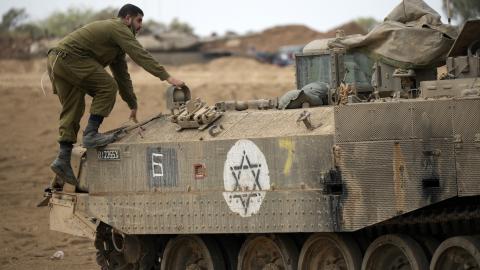Three Things about the Israel-Hamas War is a series from the Hudson Center for Peace and Security in the Middle East. Every week, Hudson Senior Fellows Michael Doran, Can Kasapoğlu, and Jonathan Schachter will join Research Fellow Zineb Riboua to offer an analysis of one thing—and one thing only—that is of particular importance to understand the Israel-Hamas war. Subscribe here.
Read their analysis below.
1. The Biden administration and Israel fundamentally disagree over war aims.
The list of issues over which the United States and Israel disagree is long and growing. Though the fighting in Gaza is only in its second month, five major points of disagreement have materialized between Washington and Jerusalem over the course of the war.
The first divergence emerged almost immediately over Israel’s decision to impose a siege on Gaza. The Biden administration balked at this, and Israel backed away from its position.
Second, the Biden team called for pauses in the fighting, both to enable civilians to escape and to allow aid workers to deliver food and supplies to those who needed it. The Israelis at first objected, insisting their operations would not cease until all hostages had been released. But, again, they backed away from their position and began implementing humanitarian pauses.
Third, senior Biden administration officials put pressure on Israel to reduce the number of civilian casualties in Gaza. They also warned, specifically, against storming Al-Shifa hospital, although retreated partially from this demand.
Fourth, friction developed over the terms of a proposed prisoner exchange. The terms of the current deal will freeze combat operations for around five days and allow increases in the amount of humanitarian assistance, including fuel, that is allowed to enter Gaza from Egypt.
Fifth, the White House rejected Israeli Prime Minister Benjamin Netanyahu’s statement that Israel would control Gaza “indefinitely” and retain “overall security responsibility” for the territory after the war ends.
Taken together, these differences are significant. Writing in Yedioth Ahronoth, Giora Eiland, a former major general in the Israel Defense Forces, sees them as stemming from competing “narratives” about the conflict. The Americans, according to Eiland, view Israel’s opponent as Hamas, a terrorist group. The Israelis, on the other hand, view their fight as against the political system that orders life in Gaza. It is this system, in Eiland’s view, that the Israelis must dismantle.
Eiland’s characterization of the disagreement between Washington and Jerusalem, while not incorrect, is incomplete. The disagreements continue to arise not just because of clashing narratives, but because of differing political visions. The Americans view a two-state solution as their ideal endgame to the war, with a reinvigorated and empowered Palestinian Authority ruling over Gaza.
Israeli society, across all major political parties, does not share this vision. It is impossible to imagine any governing coalition in the Knesset that would view rule by Palestinian Authority President Mahmoud Abbas as an adequate solution to Israel’s security dilemma. Washington and Jerusalem have a bumpy ride ahead.
— Michael Doran
2. Hezbollah is attempting to bolster its air defenses.
Hezbollah has been striving to procure a more robust air defense deterrent. Succeeding in this endeavor would allow Iran, the armed network’s patron, to make the airspace along Israel’s northern border with Lebanon far more dangerous.
In early November 2023, the Wall Street Journal cited unnamed US intelligence officials contending that the Wagner Group, a Russian paramilitary organization, is planning to transfer Pantsir short-to-medium-range air defenses to Hezbollah. Other sources have suggested that Wagner could provide the Lebanese terror group with Pantsir systems that the Syrian Arab Armed Forces are using.
In addition, Iran may be close to transferring its Khordad-15 mid-to-long-range surface-to-air missile (SAM) to Hezbollah’s control. Empowered by Sayyad-3 missiles that possess a maximum range of 120 kilometers (roughly 75 miles), the Khordad-15 is a potent system, though it has yet to see its combat debut.
Acquiring the Pantsir and Khordad-15 missiles would undoubtedly allow Hezbollah to boost its air-defense capabilities. This would provide Iran with a wider range of options for its Lebanese proxy.
Though Israel has been largely effective in deterring Hezbollah thus far, the terrorist group reportedly downed an Israeli Hermes-450 drone last week. And while Hezbollah leader Hassan Nasrallah has been comparatively restrained in his rhetoric, his forces still pose a potentially disruptive threat to Israel’s campaign in Gaza. His masters in Tehran are likely attempting to build a more robust system of air defenses without committing major combat formations to the fight.
— Can Kasapoğlu
3. The IAEA reminds a distracted world that Iran’s nuclear crimes continue.
Decision-makers in Jerusalem, Washington, and European capitals are focused on the war raging in Gaza: on the fate of the hostages, on deterring Hezbollah, on limiting Palestinian civilian casualties, and on planning for postwar eventualities.
But Iran’s centrifuges continue to spin 1,000 miles east of the fighting. Last week, the International Atomic Energy Agency (IAEA) produced its newest assessment of Iran’s nuclear program. It revealed that Iran is expanding its stockpile of highly enriched uranium, for which it has no plausible civilian need. In violation of its obligations under the Nuclear Non-Proliferation Treaty, Tehran continues to stonewall IAEA inspectors investigating undeclared nuclear activities, materials, and sites in the Islamic Republic.
The IAEA Board of Governors will meet this week to discuss the organization’s findings, but almost certainly will take no substantive action. Member states know that referring Iran’s nuclear violations to the UN Security Council would only reveal their own powerlessness, as any punitive measures would be vetoed by Iran’s allies in Moscow and Beijing.
Gaza is just one front in a larger war, with the United States, Israel, and their Arab partners and allies on one side and Iran and its terrorist proxies on the other. The Biden administration is standing by Israel as it destroys Hamas’s military and governing capabilities in Gaza. But it appears to be in denial about the broader war, which Tehran continues to fight on its own terms.
Iran, through its proxy forces, has attacked American bases in the Middle East over 60 times since mid-October. In response, the United States has attacked Iranian proxies in Syria a total of three times, reportedly after President Joe Biden rejected other targeting options that would have sent a more powerful direct message to Tehran. To make matters worse, the administration recently renewed a sanctions waiver that gives Iran access to $10 billion for the provision of electricity to Iraq.
The not-so-hidden hand of Iran is behind the fighting in Gaza, the exchange of fire between Israel and Hezbollah in Lebanon, and this week’s Houthi hijacking of a civilian cargo ship in the Red Sea. What comes next is as clear as what Washington needs to do: the regime in Tehran will continue to sow violence and instability, target American personnel, and drive a nuclear arms race in the Middle East unless the United States begins to exact a cost from Iran for its support for terrorist groups like Hamas, Hezbollah, and the Houthis; its attacks on American bases; and its grievous nuclear violations.
— Jonathan Schachter






















